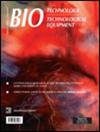Decolourization of synthetic dyes by laccase produced from Bacillus sp. NU2
IF 1.4
4区 生物学
Q4 BIOTECHNOLOGY & APPLIED MICROBIOLOGY
引用次数: 5
Abstract
Abstract Advanced industrialization has caused an increase in the continuous discharge of hazardous effluents in the environment. This study evaluated the potential of the laccase synthesized by Bacillus sp. NU2 to degrade five synthetic dyes. Sawdust, wheat bran and peels of banana and tangerine were utilized as carbon sources for bacterial growth and laccase production. The produced crude enzyme was purified to homogeneity to determine its molecular weight. The kinetic activity of the purified laccase was determined using 2,2′-azinobis-(3-ethylbenzothiazoline-6-sulfonic acid) (ABTS). The toxicity of the laccase-treated dye solution was assessed on Bacillus sp. NU2 growth. The result showed optimum laccase yield from the tangerine peel medium. The purified laccase gave a specific activity of 349.94 U mg−1 and a molecular weight of 55 kDa, respectively. The purified laccase displayed a strong affinity for ABTS substrate with an enzyme activity of 31.21 U mg−1. It was optimum at 60 °C and pH 8, with catalytic efficiency (Kcat /Km ) of 23.93 mmol L−1. The decolourization effects on Congo Red, Methyl Orange, Remazol Brilliant Blue R, Reactive Blue 4 and Malachite Green were 87%, 70%, 65%, 63% and 51%, respectively. The toxicity assay of laccase degraded dyes on Bacillus sp. NU2 showed a growth reduction of 36.75% (Malachite Green), 12.57% (Congo Red), 17.19% (Methyl Orange), 38.41% (Remazol Brilliant Blue R) and 28.14% (Reactive Blue 4). The laccase produced by Bacillus sp. NU2 holds a high catalytic potential for the detoxification of dye effluents in an environmental system.芽孢杆菌NU2产漆酶对合成染料的脱色作用
摘要先进的工业化导致环境中有害废水的连续排放量增加。本研究评估了芽孢杆菌NU2合成的漆酶降解五种合成染料的潜力。木屑、麦麸、香蕉皮和陈皮被用作细菌生长和漆酶生产的碳源。将制备的粗酶纯化至均匀,以测定其分子量。用2,2′-叠氮双-(3-乙基苯并噻唑啉-6-磺酸)(ABTS)测定了纯化漆酶的动力学活性。评价了漆酶处理的染料溶液对芽孢杆菌NU2生长的毒性。结果表明,陈皮培养基中漆酶产量最高。纯化漆酶的比活为349.94 U mg−1,分子量为55 kDa。纯化的漆酶对ABTS底物具有很强的亲和力,酶活性为31.21 U mg−1。它在60岁时是最佳的 °C和pH 8,催化效率(Kcat/Km)为23.93 mmol L−1。对刚果红、甲基橙、瑞玛唑亮蓝R、反应蓝4和孔雀绿的脱色效果分别为87%、70%、65%、63%和51%。漆酶降解染料对芽孢杆菌(Bacillus sp.NU2)的毒性试验显示,生长降低了36.75%(孔雀绿)、12.57%(刚果红)、17.19%(甲基橙)、38.41%(瑞玛唑亮蓝R)和28.14%(反应蓝4)。芽孢杆菌NU2产生的漆酶在环境系统中对染料废水的解毒具有很高的催化潜力。
本文章由计算机程序翻译,如有差异,请以英文原文为准。
求助全文
约1分钟内获得全文
求助全文
来源期刊

Biotechnology & Biotechnological Equipment
工程技术-生物工程与应用微生物
CiteScore
3.10
自引率
0.00%
发文量
90
审稿时长
1 months
期刊介绍:
Biotechnology & Biotechnological Equipment (B&BE) is an international open access journal publishing cutting-edge research. A modern world requires modern biotechnology and nanobiology. The journal is a forum that provides society with valuable information for a healthy and better life and promotes “the Science and Culture of Nature”.
The journal publishes original research and reviews with a multidisciplinary perspective; expanded case reports with a focus on molecular medical research and advanced practice in evidence-based medicine are also considered.
 求助内容:
求助内容: 应助结果提醒方式:
应助结果提醒方式:


